Folkart Books from India
Tara Books from Chennai (Tamil Nadu, India) very kindly sent me a few of their books, not for review, but as thanks following their contacting for some advice. After I saw the books, I asked - would have begged - if it was ok to scan some samples. Illustrations from three books appear below.
I'm afraid these images hardly do proper justice to the textural wonder of the handmade paper and crisp, silkscreened illustrations. The scans themselves could only have been improved by breaking the books which wasn't even a consideration: these glorious books are treasured works of art that I'll not be destroying or parting with in this lifetime.
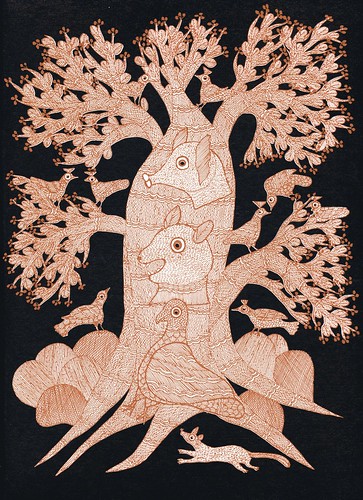
The Tree of Intoxication
"Gonds make liquor from the flowers of the Mahua tree. If you take small amounts, and mix it with good herbs, it is a medicine for many ailments. If you drink a little more, it is pleasant. But if you drink too much, your very form can change, and depending on your character, you may become a mouse or a tiger, a pig or pigeon."

Snakes and Earth
"The earth is held in the coils of the snake goddess. And the roots of trees coil around the earth too, holding it in place. If you want to depict the earth, you can show it in the form of a snake. It is the same thing."

The Silkworm's Home
"There was a time when people used plain cloth and yarn. Then they discovered that the silkworm weaves wonderful thread, and took it from him to make clothes. Before he is found, the silkworm sits in the threads of his own making on the Bamur tree."

The Creation of Trees
"When Shankar Bhagwan, the creator, made the first man, there was no tree, no leaf on earth. The man said, 'Lord, what will I eat? How will I live?' The creator pulled three hairs from his own body, and from them made three great trees. Then the man said, 'But Lord, there are no fruit on these trees. Three will remain three, and the three must die one day.' Then Shankar Bhagwan took the ash coating his matted hair and sprinkled the trees with it, and they began to flower and fruit. So in the days before we knew how to grow grain, it was trees that filled our stomachs with their fruit."
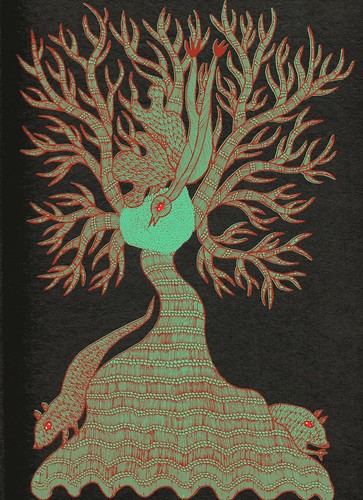
The Departing Visitors
"Everyone knew that holy spirits live in the Sembar tree. As night falls, its daytime visitors depart - bees, a bird, and two chameleons."
'The Night Life of Trees' © Tara Books Pvt. Ltd. 2006
Art: Bhajju Shyam, Durga Bai and Ram Singh Urveti.
Design: Gita Wolf and Rathna Ramanathan.
"The Night Life of Trees was conceived when Tara brought Gond artists down to Chennai to work with them; the Gond live in the northern state of Madhya Pradesh, 600 kilometres from the city of Bhopal. 'We noticed there was a tree in every story they told – ask them to draw a person, they draw a person under a tree. Ask them for a river, they draw a river running past a tree. Ask them for a bird, and it's a bird sitting in a tree.' " [source]
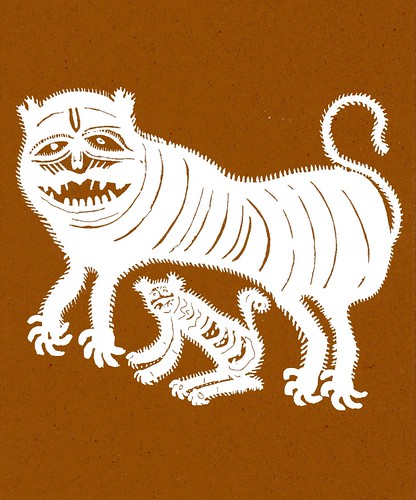
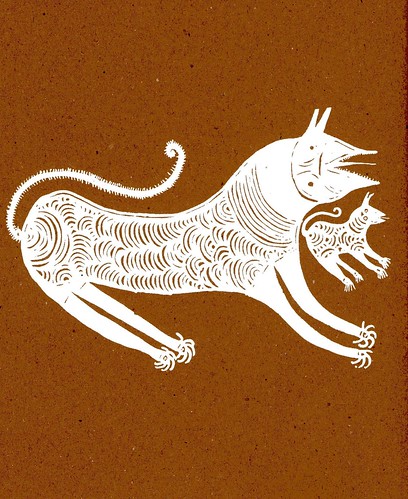



'Nurturing Walls: Animal Art by Meena Women' © Tara Books Pvt. Ltd. 2008
Photographs and screenprinted illustrations by Madan Meena.
Design: Natasha Chandani.
"Madana [public painting] is practiced by different tribes and communities in parts of Rajashtan, Gujarat and Madyha Pradesh. [..]
Meena women create beautiful Madana designs on walls and floors of the houses especially on the occasion of the Diwali festival.
For these women artists, simple shapes like squares, circles, triangles and the like become the alphabets for an exercise in picture writing.
The themes of Mandana are a variety of birds, animals and plants, as well as exquisite decorative designs which are highlighted with dots and dashes. [..]
In Mandana paintings the women record their past as well as present experiences; so we see images of creatures and things that no longer exist in their present surroundings, but are part of their memory."
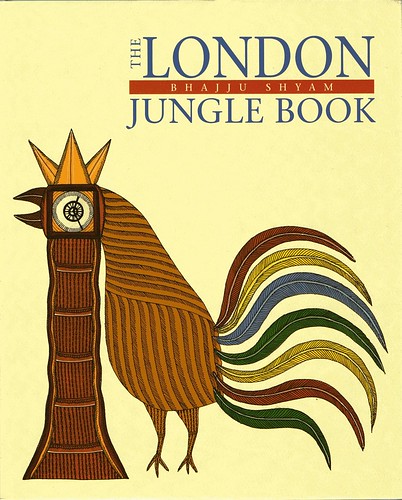
When Two Times Meet
"I have combined the rooster, which is the symbol for time in Gond art, and Big Ben, which is the symbol of time for London. I have turned the dial of Big Ben into the eye of the rooster, because it seemed to me that Big Ben is like a big eye, forever watching over London, reminding people of the time. Symbols are the most important thing in Gond art, and every symbol is a story, standing in for something else. So this painting was the easiest for me to do, because it had two perfect symbols coming together."

Loyal Friend Number 30
"Although I liked the underground very much, I still preferred to get to to work everyday by bus, because one stopped right outside my door. [..]
I have turned the Number 30 bus into a dog, because like a dog, it was a faithful and loyal friend to me. London buses look very friendly too, and fit in with the good spirit of the faithful dog."
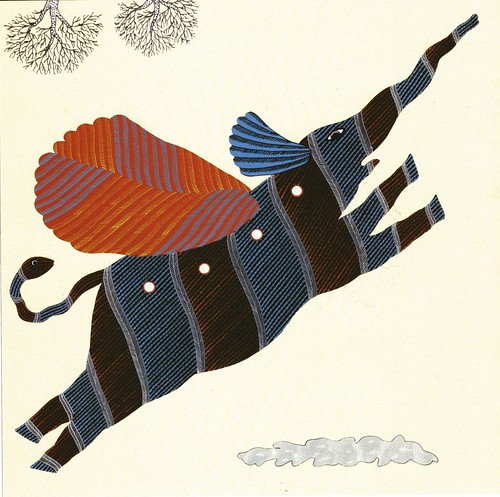
The Miracle of Flight
"The heaviest animal I have ever seen is an elephant. So that is the creature that came to mind when I painted the plane. A plane taking off is as much of a miracle as an elephant flying. I have put the trees upside down in the sky, and the clouds below, because flying turned my world upside down."

"Everyone was a foreigner - all kinds of skin colours and all kinds of hair. I had seen foreigners before - some of them had visited my village to look at our paintings, but now I realized that something strange had happened. My colour was different, my language was taken away from me ... I myself had become a foreigner!"
'The London Jungle Book' © Tara Publishing 2004
(in association with The Museum of London)
Art: Bhajju Shyam
Text: Sirish Rao & Gita Wolf (from Bhajju's oral narration)
Design: Rathna Ramanathan*, Minus9 Design*
"Bhajju is a brilliant artist from the Gond tribe in central India, and this book is a visual travelogue of his impressions in London. With radical innocence and great sophistication, Bhajju brings the signs of the forest to bear on the city, turning London into an exotic jungle." [back cover blurb]
- Tara Books.
- Tara Books - recommended stores (international outlets).
- Tara Books blog / twitter / facebook.
- Tara Books at Amazon
- 'India's Implausible Publishing Success Story' (Globe & Mail, July 2009)
- [Book by Its Cover & Drawn!]




No comments:
Post a Comment